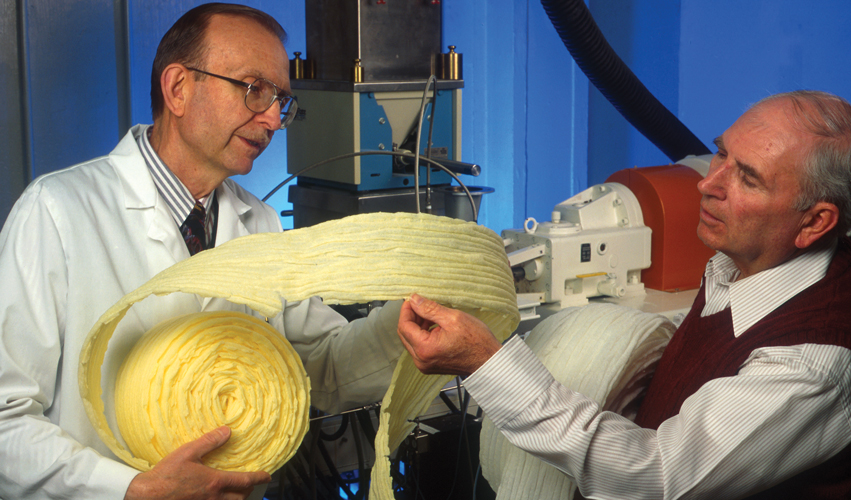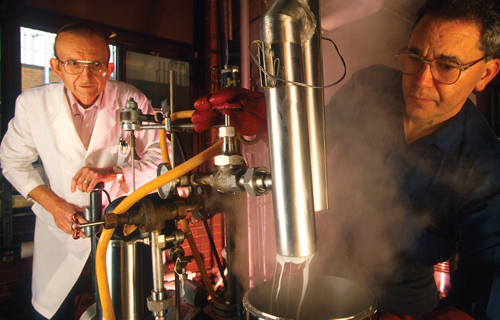
Advances in the USDA Peoria Ag Lab can help springboard rural America into economic prosperity.
From improving agricultural production and the economic security of U.S. farmers and rural communities, to ensuring the American food supply is safe and nutritiously healthy, the USDA National Center for Agricultural Utilization Research (NCAUR), also known as the USDA Ag Lab, continues to pursue transformative advances at the frontiers of agricultural research.
The USDA Ag Lab in Peoria is one of four premier research centers—and the largest of all. It is tasked by Congress to provide critical solutions to agricultural problems of top national priority and develop innovative technologies that directly benefit the economy of rural America.
Transformative Research
In nearly 77 years of existence, the USDA Ag Lab has made tremendous contributions to agricultural sciences and the national economy by taking on risky, transformative research. Millions of dollars in licensing revenue from the Ag Lab go to the U.S. Treasury every year. Millions more are generated in the economy through technology transfer to agricultural businesses and farmers. For every dollar spent on research at the lab, the economy realizes $10 in gain, according to the USDA Economic Research Service.
If you have ever enjoyed a nutritional supplement drink such as Ensure or Glucerna, you have benefited from research at the Ag Lab in Peoria, where hundreds of patents have been licensed. The majority of the patents and inventions developed in the Peoria Ag Lab are licensed by small businesses and startup companies.
Some of these inventions have contributed to creating new business sectors in small-town America. For example, Z-Trim, a fat replacer made from dietary fiber, is produced by Z-Trim Holding in Mundelein, Illinois. Renewable motor oil, developed in the lab, is another example. The super-absorbents found in many consumer products originated at the Peoria Ag Lab. This is a huge industry, not only for baby diapers, but also soil amendments and other industrial applications, such as oil drilling and fracking.
Biological pest control that does not rely on toxic chemicals may one day help eradicate West Nile and Zika-carrying mosquitoes and ticks, as well as destructive Japanese beetles. These new-generation pesticides will also help organic food crops thrive. The development of test methods and kits to detect mycotoxins in grains helps improve food safety and allows grain farmers to gain market access overseas. These are only a few of the inventions from the USDA Peoria Ag Lab that directly benefit the rural economy.
Reversing Decline
Using federal and other data, The Wall Street Journal recently published an article portraying the dilapidated landscape of rural America as “The New ‘Inner City.’” The causes of rural and small towns’ decline are many. Chief among them are the loss of manufacturing jobs and income in an increasingly knowledge-based economy.
The federal government, particularly the USDA, has implemented many programs and initiatives to help reverse this decline. The key to revitalize rural America—by building vibrant, enduring neighborhoods and communities where young people want to stay—is to develop new income sources for farmers and new agricultural businesses based on inventions developed in places like the Ag Lab.
Currently, Peoria Ag Lab scientists are developing a soybean-based, rubber-like material that could potentially replace synthetic rubbers in many applications. This is just one of many research projects in the Ag Lab that support value-added products from agricultural land, resulting in increased value for agricultural commodities and increased income for soybean farmers.
In addition, scientists in the Peoria Ag Lab are developing processes and products based on non-crop plants that can grow on marginal or reclaimed land, or off-season. Plants with oil-bearing seeds produce a variety of oils with different fatty acid profiles, which can be converted into fuels, lubricants and plastics. Many oilseed crops also produce protein, which can be used as emulsifiers, enhanced animal feeds, or other industrial products, such as water-resistant bioplastics.
One such crop under development is pennycress. Pennycress is a winter-grown crop that is harvested in the spring, allowing for dual-cropping with corn or soy. By adding another season to crop production, farmers can increase their revenue from existing agricultural land.
Biomass, which could be crop residuals or non-crop plants, is another class of plants that can be utilized to support regional biorefineries—facilities that integrate biomass conversion processes and equipment to produce fuel, power, heat and value-added chemicals. New biorefineries will be located in rural areas to minimize transportation and storage costs, resulting in increased employment and infrastructure improvements. Some examples of chemical feedstocks include aromatics, small vinyl molecules for plastics, industrial alcohols, fuel components and essential oils. Value-added products include new low-caloric sweeteners, viscosity modifiers, emulsifiers and plastics.
New Frontiers
In recent years, the USDA Peoria Ag Lab has undergone extensive renovations at a cost of about $100 million through Congressional appropriations. These infrastructure investments have vastly improved functions and energy efficiency, enhanced research capacities and diversities, and more importantly, added a lot of state-of-the-art scientific equipment that helps open new research frontiers.
The men and women in the USDA Peoria Ag Lab are excited about the successes they have achieved. They look forward to continuing along this path, driving further advances in transformative agricultural research and technology transfer in order to help springboard rural America into prosperity with strong economic development and job creation. iBi
Sean Liu, PhD, is a research leader in the Functional Foods Research Unit at the National Center for Agricultural Utilization Research in Peoria.

